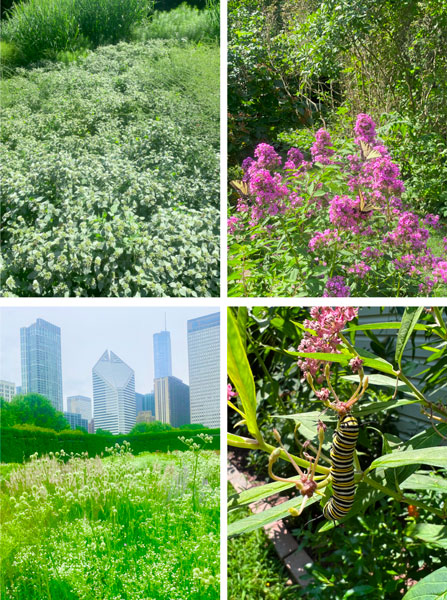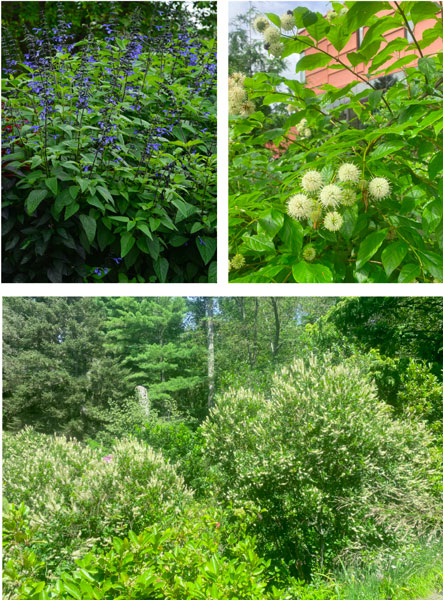10/1/2023
Great Pollinator Plants for the Home Garden
Andrew Bunting

Interest in creating home gardens with pollinator-attracting qualities is at an all-time high. Many great non-profits, such as the Xerces Society, Monarch Watch and Doug Tallamy’s Homegrown National Park, have made information about pollinator gardens and the important ecological functions they serve mainstream.
I was talking to a garden center owner recently who said that he cannot keep Asclepias tuberosa, the butterfly milkweed “on the shelf.” Even when it’s not in bloom, demand is high. Many garden centers are also creating specific areas in the store that feature native pollinator plants that are ideal for their particular climate or feature brands like American Beauties Native Plants. Here are more options for your consideration.
Pictured, clockwise from top, left: Pycnanthemum muticum, as seen at Chanticleer, a public garden outside of Philadelphia. • Phlox paniculata Jeana being visited by a Swallowtail butterfly at Chanticleer. • Eryngium yuccifolium blooming on a summer day at the Lurie Garden in Chicago’s Millennium Park. • Native milkweed Asclepias syriaca is one of the main food sources for Monarch caterpillars (this particular plant helped feed nearly a dozen Monarch caterpillars this summer).
The Mountain Mints
The best-of-the-best plants for the pollinator garden without a doubt are the mountain mints (pycnanthemum). Pycnanthemum muticum thrives in full sun, but can withstand shade as well. It quickly grows into large colonies in the garden through expanding its underground stems. Reaching 3 ft. tall, it’s a great perennial for the front border of a garden. The foliage and flower bracts are a smokey-white and the flowers have small globular heads that are highly attractive to many pollinators. The leaves have a minty fragrance when crushed and pycnanthemum is truly deer resistant.
Another great set of mountain mint varieties that are also pollinator plants are the Virginia mountain mint Pycnanthemum virginianum and the fine foliaged species Pycnanthemum tenuifolium. The hoary mountain mint, Pycnanthemum incanum, has larger attractive bracts and reaches 2-ft. tall at maturity.
Ornamental Onions
There are a host of ornamental onions (allium). These differ from the large, globe-like allium that bloom in May in that they remain perennial for the summer, with clumps of dark green basal leaves. Like all members of this genus, allium are truly deer resistant. Allium lusitanicum Summer Beauty has abundant globes of lavender flowers in the summer and reaches 1.5 ft. tall. It attracts native bees, honeybees, bumble bees, butterflies and pollinating wasps. Allium Millennium, with rose-pink flowers, has proved to be a strong plant in the gravel garden. Medusa is another great choice, with lavender-purple flowers.
Other Great Herbaceous Plants
A tremendous garden phlox is Phlox paniculata Jeana. This summer-flowering phlox blooms for several months and is covered with an abundance of flower heads with small, fragrant, pink flowers that are a magnet to myriad butterflies and the Ruby-throated hummingbird. Jeana also has great resistance to powdery mildew, which ravages most cultivars of garden phlox.
A great native of the Midwestern prairies is the rattlesnake master Eryngium yuccifolium. Blooming from June to September, this drought-tolerant perennial will reach up to 5 ft. tall. At the base, it sets a rosette of serrated leaves and towering above the foliage are wiry stems with a spray of white, thimble-like flowers. This stalwart native has an architectural quality. The rattlesnake master attracts an abundance of pollinating bees, wasps and flies. The self-sowing annual Eryngium leavenworthii has striking purple flowers and is also an attractant for pollinators. It’s native to Arkansas, Kansas, Missouri, Oklahoma and Texas.
The Coneflowers
Of course, one of the best and most attractive of all the perennials to attract pollinators is the host of coneflowers (echinacea). Over the last 20 years, the coneflowers have had an amazing renaissance in American gardens. Over this period, literally hundreds of species, hybrids and cultivars have been selected and promoted for their beauty and ability to attract a variety of pollinators, including long-tongued bees and butterflies, such as fritillaries, Monarchs, Painted Ladies and Swallowtails.
 Pictured, clockwise from top, left: Salvia guaranitica Black and Bloom is a hummingbird magnet. • Cephalanthus occidentalis at the Scott Arboretum at Swarthmore College in Swarthmore, Pennsylvania. • Clethra alnifolia, showing off white wand-like, fragrant flowers.
Pictured, clockwise from top, left: Salvia guaranitica Black and Bloom is a hummingbird magnet. • Cephalanthus occidentalis at the Scott Arboretum at Swarthmore College in Swarthmore, Pennsylvania. • Clethra alnifolia, showing off white wand-like, fragrant flowers.
The purple coneflower, Echinacea purpurea, now comes in many colors, including orange, yellow, pink, white and even red. At a recent trip to a local nursery in New Jersey, the recommended two exceptional cultivars were Kismet Intense Orange and Kismet Red. Plant evaluations conducted at the Mt. Cuba Center in Delaware also determined Pica Bella, Sensation Pink, Santa Fe, Snow Cone, Glowing Dream, Fragrant Angel and Julia to be exceptional cultivars.
Other great species include the Tennessee coneflower, Echinacea tennesseensis, with rose-pink flowers; the pale pink coneflower, Echinacea pallida, with long drooping petals and shuttlecock-like flowers; and Echinacea paradoxa, with black-eyed-Susan-like yellow flowers with a black center. When coneflowers finish flowering, they become a great food and seed source for the American Goldfinch.
The Monarchs
The plight of the Monarch and other butterflies has become mainstream news. Awareness has been raised by Monarch Watch and the Xerces Society, amongst others, regarding the importance of creating habitat for the Monarchs. The best way to do this is to plant several species of native milkweeds, including Asclepias tuberosa (butterfly milkweed), which has striking orange flowers. Asclepias syriaca, the common milkweed, can reach 5-ft. tall and has large, round clusters of soft pink flowers. Other lesser-known species can be added, such as Asclepias purpurascens and Asclepias verticillata, to add diversity for the butterflies.
Don’t Forget the Hummingbirds
While most pollinators are moths, butterflies, wasps, etc., all the species of hummingbirds pollinate a multitude of flowers. Any tubular flower will undoubtedly attract hummingbirds. All the salvias are great hummingbird magnets. Salvia guaranitica Black and Bloom reaches 4 to 5 ft. tall and has tubular, smokey blue flowers. For a summer annual display, the Mexican bush sage, Salvia leucantha, is covered in spikes of velvety lavender-purple flowers for most of the season. The Mirage series of the native Salvia greggii has shades of flowers, including blue, pink, salmon and white, and is perfect for the container garden or small space. Other great plants for attracting hummingbirds include penstemon, aquilegia, fuchsia, zinnia and even hostas when in flower.
Shrubs for Pollinators
The buttonbush, Cephalanthus occidentalis, produces pendant, orb-like, white flowers in the summer. This native shrub reaches up to 10-ft. tall and is often found growing in wet areas or on the side of a lake or pond. Sugar Shack is more diminutive in size, reaching only 5-ft. tall with an equal spread. The summersweet Clethra alnifolia has white or pink wand-like, fragrant flowers in the middle of the summer. It, too, like cephalanthus, is very adaptable to moist areas, including pond edges. Ruby Spice has pink-red flowers and Hummingbird is a great ground-covering plant reaching only 2-ft. tall. In the fall, the leaves turn a vivid golden-yellow. While not native, the chaste tree, Vitex agnus-castus, produces violet, blue or white spires of flowers in the late summer that attract tons of pollinators.
The above is a non-exhaustive snapshot of a variety of great pollinator plants that can act as a reference point for anyone interested in adding more pollinator plants to their garden. You can also find a variety of pollinator plants at your local garden center or nursery that will suit your specific gardening zone and individual garden conditions, making it simple to support local ecosystems while adding beauty and ornament to your space. GP
More Resources
Check out these links for more pollinator information and programs:
Xerces Society: xerces.org
Monarch Watch: monarchwatch.org
Doug Tallamy’s Homegrown National Park: homegrownnationalpark.org
Pollinator Partnership: pollinator.org
Andrew Bunting is the Vice President of Horticulture for the Pennsylvania Horticultural Society, which uses horticulture to advance the health and well-being of the Greater Philadelphia region. Andrew has decades of horticultural experience, ranging from his tenures at public gardens in the U.S. and abroad, as well as a published author, gardening expert and sought-after presenter. To learn more about PHS, or to become a member and support greening initiatives in over 250 neighborhoods, visit PHSonline.org.